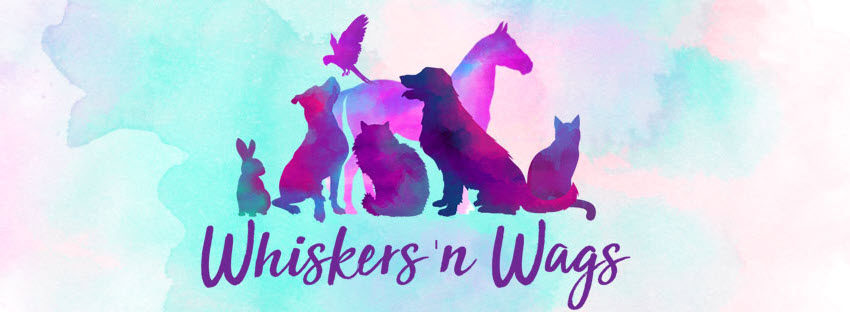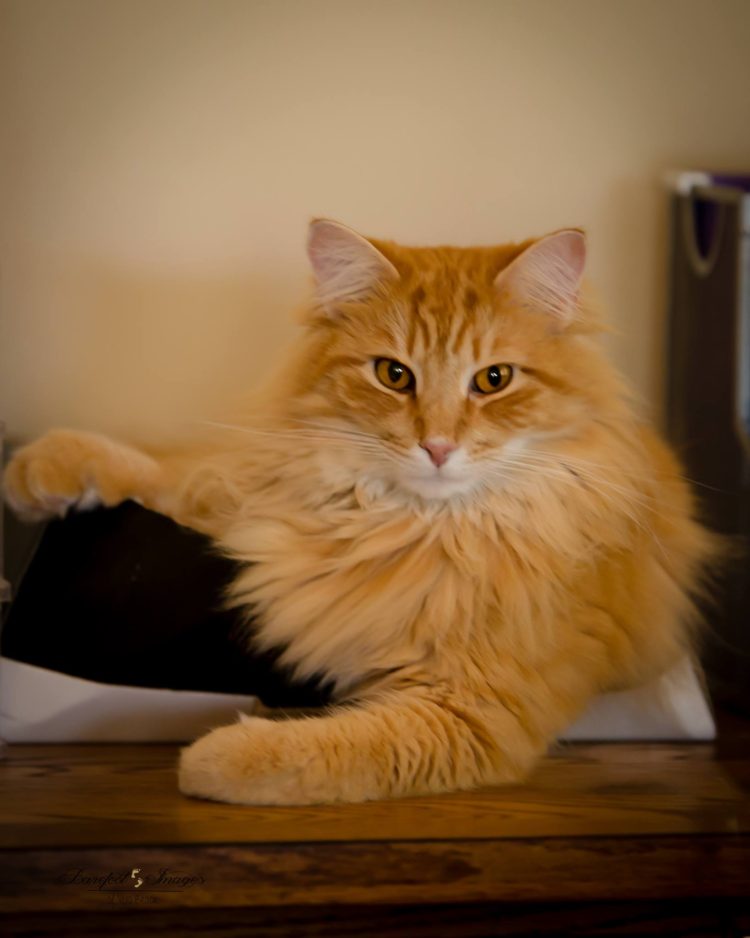9 Reasons Why Orange Cats are the Best Cats
Even though Ginger Cat Appreciation Day happens in September, any day to recognize these cute, adorable, yet often overlooked reds is a reason to celebrate!
Most Americans remember the iconic ginger cat characters like Garfield with his funny, quirky, fun-loving attitude, and Hobbes of Calvin and Hobbes, who embodies playfulness and feline instincts and even though Jim Davis, the creator of the Garfield comic featured cats of various colors, the big orange Garfield is the one everyone remembers. What’s so fascinating about the orange tabby? Is there just something daring about keeping what looks like a baby tiger in your house? Maybe that orange color is just warm and exciting.
Ginger cat fans probably know these already, but let’s take a look at these 7 Reasons Why Orange Cats are the Best Cats.
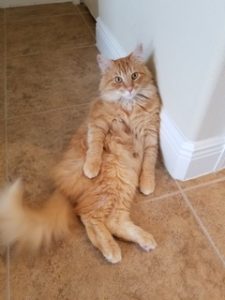
Here are Some Orange Cat Facts:
1. It really is a coat pattern rather than a breed
Nearly every cat breed not dependent on color can have the orange tabby pattern. While some breeds are more likely to produce orange pigments rather than others, this is not a cat breed but simply a coat variety. The color could be pale or bright. It could be a shade of orange closer to red or yellow or more brownish.
The breeds that most commonly have this pigment are Maine Coons, Munchkins, Egyptian Maus, British Shorthairs, Bengals, Abyssinians, American Bobtails and Persians.
2. The orange hue comes from a distinct pigment
Orange tabbies all have their own distinct shades and tints, but they all will have some variance of an orange, reddish or perhaps even cream-colored hue. The reason for this is because these cats have a dominance of a particular pigment known as pheomelanin. This is the same pigment that creates red hair in humans.
Cartman from South Park would like to convince people that ginger kids don’t have souls. That does not seem to apply to ginger cats at all! Anyone who owns one of these orange tabbies will tell you that they are just the world’s biggest sweethearts!
3. Orange tabby fur can be blended with white spots
This is especially true in patched tabbies. Many orange cats will have white legs and a white underbelly. The paws, chest and tail tip may also be white.
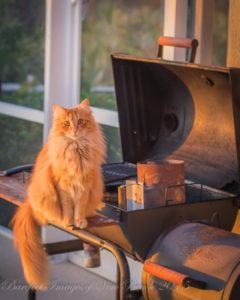
4. Every orange cat is a tabby
But not every tabby is an orange cat. You can have a golden tabby, a silver tabby, a cream tabby or a yellow tabby. All orange cats have stripe patterns, however faint. Solid orange simply is not a color trait found in cats.
5. Orange Cats can have long or short hair
Long haired breeds such as Persians, Maine coons and American curl can have the orange tabby pattern. Abyssinians are favored for the orange ticked pattern. Bengals, and Savannah cats look like pint-sized tigers. So, whether your cat has long and fluffy or short and fuzzy hair, they can be of the ginger persuasion.
5. They have a tendency to develop black freckles
Just like redheaded humans are likely to develop freckles, so are ginger cats! You may find tiny black spots on his skin. They will be most noticeable on the lips and nose where the fur is the thinnest. They tend to develop them at a year or two old.
6. The orange tabby will usually have one of five varying kinds of coat patterns
There are five basic types of this pattern: classic tabby, spotted tabby, ticked tabby, patched tabby and mackerel tabby.
- The classic tabby will have a butterfly pattern on his back or a bull’s eye pattern on his sides, appearing as if the cat was tie dyed.
- A spotted tabby will look more like a leopard or a jaguar with rosette or oval markings rather than stripes. Ticked tabbies (also known as agouti) have most of the tabby markings on their face.
- Patched tabbies will have large swathes of color as well as stripes. The mackerel tabby will have stripes just like a tiger.
7. Orange tabbies tend to be very vocal
National Geographic has found that personality can be tied to a cat’s fur color. Orange cats were found to be the most sociable. They both purr and meow a lot and will always want to be near their favorite humans. Some are even referred to as more like dogs than a typical independent (or antisocial) cat. They are known for being very affectionate and not shy at all, given the proper upbringing.
8. Orange tabby cats have a big appetite
Besides orange color, the one thing they have in common is being on the pudgy side. Famous fictional cats, Garfield and Heathcliff are well known for pulling off crazy antics to get more food than they were due. Tiger from An American Tale claimed to be vegetarian but while he had misgivings against eating something that could talk, sing and dance with him, he had no problem at all with fish.
Oliver of Oliver and Company was only a kitten, but like his namesake from Dickens, he always wanted some more. Morris, the spokescat for 9Lives, is on the svelte side but not shy about showing his love for his favorite cat food. Orange cats have a tendency towards a big appetite.
Could having orange fur stimulate a cat’s appetite? Considering they don’t see color quite like we do, that perhaps is not the reason. Maybe the bright orange coat and cute little face makes us think of food and that makes us think of feeding the cat. At any rate, if you own an orange cat see that his weight stays in a healthy range so he doesn’t suffer diabetes or joint damage. This is particularly important if he seems to be low in energy.
9. Eye Colors of Ginger Cats
While all kittens have blue eyes to start with, they will usually change to other colors as they grow up. The eyes of ginger cats eyes may be bright green, golden, or a copper tone. Many have bronze eyes like topaz stones. Most, however, will have gold or green eyes.
There you have it! A small list of 9 reasons orange cats are the best cats! Now, I’ll touch on a few more fun ginger cat facts.
Ginger Cat Personality
While ginger cats have a reputation for being friendly yet on the lazy side, the truth is that it is their early socialization with people and other cats that affects their personality more than anything. Some tabbies can be a bit on the brave side because their pattern makes stalking so easy for them. The people who have owned orange tabbies claim that they have the most charming personalities.
Of course, you must expect them to be a little prejudiced towards their own cats! Every cat is an individual with their own personality. Treat a cat well from the time he’s a kitten and you will get a healthy, well adjusted family member.
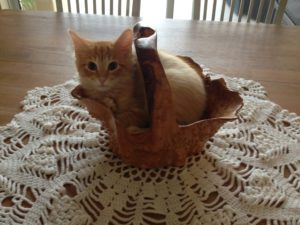
Is every orange tabby cat a tom?
While it is a fact that there is a higher ratio of orange tabbies that are male, Orange tabby cat toms outnumber queens approximately four to one!
That is just how genetics work. The X chromosome is the reason for the orange coloring. Every female animal (and human) possesses two X chromosomes and every male possesses an X and a Y chromosome. Hence, an orange tabby queen would only result if both her father and mother passed on the orange genes.
An orange tom only requires the orange gene from his mother. This is the direct opposite of the calico or tortoiseshell pattern that is predominantly female. Interestingly, while the odd male calico tends to be sterile the odd orange female seems to have no problem reproducing.
What does that “M” on the tabby cat’s head stand for?
Here are a few theories…maybe you’ve heard of one or more of them?
- According to Christian legend, the M stands for Mary because she kissed a tabby on the head for keeping Jesus warm.
- According to Islamic legend, the M stands for Mohammed because he petted a cat on the head for protecting him from a cobra while he slept.
- One far fetched “Just So” story says that the M appeared on a tabby’s head because he stared too long in concentration at a mouse hole.
In reality, tabby stripes developed as a form of camouflage in the wild. The M could be a way of disguising bright eyes among shadows.
Orange tabby cats in history:
While the origins of the word “tabby” are steeped in mystery, one possibility is from the Arabic word “attabiya”, referring to Attabiy, a place in Baghdad known for making silk with a striped pattern. As the pattern is so common in the wild, many medieval cats were likely tabbies.
Winston Churchill had an orange cat named Tango. Perhaps it was because he looked like a tangerine or perhaps he moved like a dancer. He also had one named Jock and made a stipulation in his will that an orange tabby named Jock must always reside at Chartwell.
The beautiful orange cat has shown up in art. Utagawa Kuniyoshi did a xylograph called Woman Holding a Cat depicting a woman in a traditional kimono holding an orange and cream feline.
Horatio Henry Couldery had a whole series of paintings depicting mackerel cats and kittens getting up to mischief.
Henriette Ronner-Knip did an oil painting of a mother calico with three ginger kittens appropriately titled Contentment. John James Audubon, better known for his placid bird paintings, depicted a ginger cat and a black cat fighting viciously over the bloody corpse of a squirrel in Two Cats Fighting.
The cat Pablo Picasso depicts in Cat Eating a Bird is a brindled orange. Many fairy tale cats such as Puss in Boots, Dick Whittington’s Cat and the Cat and the Fiddle are depicted as ginger tabbies.
Dr. Tsai Ing-wen, the President of Taiwan, has an orange tabby named Ah Tsai whose name means “talent”. British author Katherine Hale wrote a series of children’s books back in the Thirties based on her family’s cat, Orlando.
The previously mentioned Morris was originally a shelter cat, as has ever “Morris” 9Lives selected as their spokescat.
A Street Cat Named Bob, a film about a cat named Bob saving his human friend James Bowen from heroin addiction, won Best British Film in 2017.
Other thespian felines have included Orangey from Breakfast at Tiffany’s, Milo of Milo and Otis, the cats who played Spot on Star Trek the Next Generation, Orion from Men in Black and Crackerjack, who played the half-kneazle Crookshanks in the Harry Potter film series.
Conclusion
While I wrote this article, I have featured my own ginger sweetheart, Romeo in all of the photos I’ve used. At the same time, I am fostering a pair of ginger babies that I received when they were topping the scale at a mere 9 and 10 ounces and spent some time bottle feeding them and getting them used to eating on their own. One is male, and the other is female. Both are extremely outgoing, loud purr machines and long-haired. My Romeo developed freckles on his bottom lip and just inside of his mouth that were not there as a young kitten. Interesting!
Resources:
- Cat Coat – Color, Pattern and Genetics by Sonja Prohaska
- Basic Feline Genetics at The Cat Fanciers’ Association
- Cat coat genetics
- Feline Coat Color Tests Veterinary Genetics Laboratory
- Black Spots (Lentigo) on Cats Gums, Nose and Eyelids By Julia Wilson
- Feline Find: How the Tabby Cat Got Its Stripes By Stephanie Pappas
